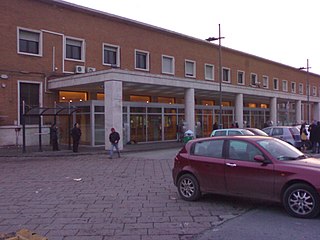
Novara railway station is the main station serving the city and comune of Novara, in the Piedmont region of northwestern Italy. Opened in 1854, it forms part of the Turin–Milan and is the origin point of the lines to Arona, to Alessandria, to Biella, Varallo, Domodossola and Luino.

Vercelli railway station is the main station serving the city and comune of Vercelli, in the Piedmont region, northwestern Italy. Opened in 1856, it forms part of the Turin–Milan railway, and is also a junction station for two other lines, to Valenza and Pavia, respectively.

Grosseto railway station is the main station serving the city and comune of Grosseto, in the region of Tuscany, central Italy. Opened in 1864, it forms part of the Pisa–Livorno–Rome railway.

Massa Centro railway station serves the town and comune of Massa, in the region of Tuscany, central Italy. Opened in 1862, it forms part of the Pisa–La Spezia–Genoa railway.

Civitavecchia railway station serves the town and comune of Civitavecchia, the sea port for Rome, in the region of Lazio, central Italy. Opened in 1859, it forms part of the Pisa–Livorno–Rome railway.

Formia-Gaeta railway station, previously named Formia railway station, serves the cities and comunes of Formia and Gaeta, in the region of Lazio, central Italy.

Foligno railway station serves the town and comune of Foligno, in the region of Umbria, central Italy. It is also the most important railway junction in Umbria. Opened in 1866, it forms part of the Ancona–Orte railway, and is the southeastern terminus of the Foligno–Terontola railway, which links Florence with Rome.

Terni railway station serves the town and comune of Terni, in the region of Umbria, central Italy. Opened in 1866, it forms part of the Ancona–Orte railway, and is also a junction station for two secondary lines, the Terni–Sulmona railway and the Terni–Sansepolcro railway.

Campi Flegrei is a station on Line 2 of the Naples Metro. It was opened on 20 September 1925.

Foggia railway station serves the city and comune of Foggia, in the region of Apulia, Southern Italy. Opened in 1864, it forms part of the Adriatic Railway (Ancona–Lecce), and is the terminus of the Naples–Foggia railway. It is also a junction for several other, secondary lines, namely the Foggia–Manfredonia, Lucera–Foggia and Foggia–Potenza railways.

Monza railway station is the main station serving the city and comune of Monza, in the region of Lombardy, northern Italy.

Gallarate railway station serves the town and comune of Gallarate, in the region of Lombardy, northern Italy. Opened in 1860, it is part of the Domodossola–Milan railway, and is a terminus of two secondary railways, Luino–Milan railway and Porto Ceresio–Milan railway.

Lecco railway station is the main station serving the town and comune of Lecco, in the region of Lombardy, northern Italy. Opened in 1863, it is the junction of five lines, namely to Bergamo, to Como, to Milan, to Molteno and Monza and to Tirano.

Lodi railway station serves the city and comune of Lodi, in the region of Lombardy, northern Italy. Launched 1861, it lies along the Milan–Bologna railway.

Modena railway station is a railway station serving the city of Modena, in the region of Emilia-Romagna, northern Italy. The station opened in 1859 and is located on the Milan–Bologna railway, Verona–Modena railway and Modena–Sassuolo railway. The train services are operated by Trenitalia and Ferrovie Emilia Romagna.

Forlì railway station serves the city and comune of Forlì, in the region of Emilia-Romagna, northern Italy. Opened in 1926, it forms part of the Bologna–Ancona railway.

Reggio Emilia is a railway station serving the city of Reggio Emilia, in the region of Emilia-Romagna, northern Italy. The station opened in 1859 and is located on the Milan–Bologna railway, Reggio Emilia–Ciano d'Enza railway, Reggio Emilia–Guastalla railway and Reggio Emilia–Sassuolo railway. The train services are operated by Trenitalia and Ferrovie Emilia Romagna.

Caserta railway station serves the city and comune of Caserta, in the region of Campania, southern Italy. Opened in 1843, it forms the junction between the Rome–Cassino–Naples railway and the Naples–Foggia railway.

Benevento railway station is the main station serving the city and comune of Benevento, in the region of Campania, southern Italy. Opened in 1868, it forms part of the Naples–Foggia railway, and is also a terminus of three secondary railways, linking Benevento with Campobasso, Avellino, and Cancello, respectively.

Aversa railway station serves the town and comune of Aversa, in the region of Campania, southern Italy. Opened in 1867, it forms the junction between the Rome–Formia–Naples railway and the Naples–Foggia railway.





















